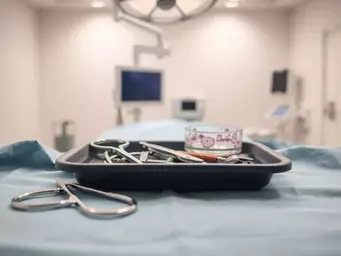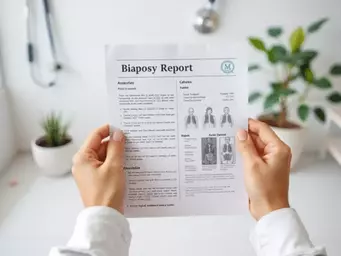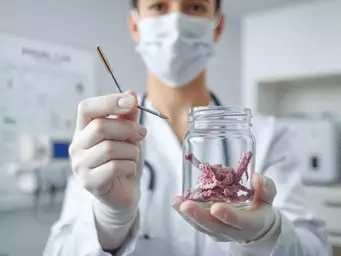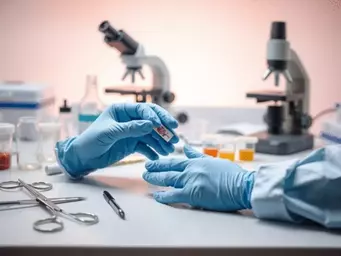Understanding your biopsy pathology report is essential for taking control of your health. It can feel daunting, but with the right guidance, you can navigate it confidently. Let’s empower you with the knowledge needed to make informed decisions about your healthcare.
What You Will Learn
- A biopsy pathology report contains crucial information including patient details, specimen type, and findings from the tissue analysis.
- Understanding your report can clarify your diagnosis, guide treatment options, and inform necessary follow-up care.
- Pathologists play a key role in interpreting biopsy results, helping to ensure accurate diagnoses and effective treatment plans.
- Engaging actively with your healthcare provider after receiving your report is vital for understanding your diagnosis and exploring treatment possibilities.
- Connecting with patient stories can provide reassurance and perspective as you navigate your health journey.
- Adhering to follow-up procedures and appointments is crucial for ongoing health management and timely intervention.
Understanding Your Biopsy Report Journey
Navigating a biopsy report involves a clear process, from receiving the document to understanding its implications for your health and treatment. This visual outlines the key steps and their importance.
1. Receiving the Report
This document details findings from the tissue sample, outlining cell nature and characteristics.
- Patient Information
- Specimen Type
2. Importance & Impact
Reports provide definitive info crucial for treatment plans, guiding next steps in care.
- Diagnosis Confirmation
- Guiding Treatment
3. Pathologist's Role
Experts analyze specimens, identifying cell changes and providing comprehensive findings.
- Expert Analysis
- Collaboration
4. Post-Report Actions
Schedule follow-up, discuss results, and explore treatment options with your provider.
- Schedule Follow-up
- Discuss Treatment
Understanding Biopsy Pathology Reports: A Guide for Patients
Receiving a biopsy pathology report can feel overwhelming, but understanding it is crucial for your health journey. A biopsy is a small procedure that can provide significant insights into your medical condition. In this section, we'll explore the essentials of biopsy pathology reports, helping you to read and comprehend them with confidence.
At What Is A Biopsy, we believe that knowledge is power. By familiarizing yourself with your pathology report, you can engage in more informed discussions with your healthcare provider. Let’s get started!

What Is a Biopsy Pathology Report?
A biopsy pathology report is a document prepared by a pathologist that details the findings from your biopsy. It includes critical information about the tissue sample that was examined under a microscope. Typically, this report outlines the nature of the cells present, whether they are healthy or indicate disease, and other relevant characteristics.
- Patient Information: Basic details about you, including your name and the date of the procedure.
- Specimen Type: The type of biopsy performed (e.g., needle, surgical).
- Findings: A summary of what the pathologist observed in the tissue sample.
Understanding these elements can clarify your diagnosis and guide your treatment options. It’s important to review this report carefully and reach out with any questions.
Why Are These Reports Important for Your Health?
Biopsy pathology reports are vital because they offer definitive information that affects your treatment plan. They help determine whether further testing, monitoring, or treatment is necessary. Without this report, your healthcare team may lack the necessary details to make informed decisions regarding your care.
- Diagnosis Confirmation: The report confirms whether a suspected condition is present.
- Guiding Treatment: Results help tailor treatment plans specific to your diagnosis.
- Follow-Up Care: It informs the need for additional tests or follow-up appointments.
Having a clear understanding of your report can significantly reduce anxiety and empower you to take an active role in your healthcare decisions.
The Role of Pathologists in Interpreting Biopsy Reports
Pathologists play a crucial role in the diagnostic process as they are the experts who analyze biopsy specimens. With years of specialized training, they assess the tissue samples and provide comprehensive reports on their findings. This expertise is essential in determining the nature of the cells and any abnormalities present.
- Expert Analysis: Pathologists identify changes in cell structure that may indicate disease.
- Collaboration: They work closely with your healthcare team to ensure accurate interpretations.
- Continued Education: Pathologists stay updated on the latest research and technologies in the field.
Knowing the role of pathologists helps you appreciate the dedication behind your biopsy report. Their insights are vital in guiding your next steps in treatment and care.
We Want to Hear From You!
What was your experience like when you received your biopsy report? Share your thoughts below:
What to Do After Receiving Your Biopsy Report
Receiving your biopsy report can be both a relief and a source of anxiety, as it often answers lingering questions about your health. The next steps are crucial to understanding your diagnosis and exploring treatment options. Let’s take a closer look at how to navigate this important phase in your healthcare journey.
First, it’s important to take a moment to process the information provided in your report. If you have any questions—big or small—don’t hesitate to jot them down. It’s perfectly normal to feel overwhelmed, and having your questions ready can help guide your discussions with your healthcare team.

Next Steps: Understanding Your Diagnosis and Treatment Options
Once you have your report, the first thing you should do is schedule a follow-up appointment with your healthcare provider. This meeting is your opportunity to discuss the results in detail. Here’s a quick checklist of what to cover:
- What does my biopsy report indicate?
- Are there any further tests needed?
- What treatment options are available based on my diagnosis?
- What are the potential side effects of these treatments?
By actively engaging in this conversation, you can gain a clearer picture of your health and make informed choices about your treatment moving forward. Remember, I always encourage my patients to advocate for themselves during these discussions—your voice matters!
How Patient Stories Can Provide Reassurance and Perspective
Hearing from others who have been in similar situations can be incredibly comforting. Patient stories often illuminate the emotional and practical aspects of dealing with a biopsy diagnosis. You might find it helpful to seek out support groups or forums where individuals share their experiences.
- Look for online communities or social media groups focused on biopsy experiences.
- Consider talking to friends or family members who have faced similar health challenges.
- Reflect on what helped them cope and what advice they found most useful.
These shared experiences not only provide reassurance but can also inspire hope and a sense of connection during a time when you may feel isolated.
Follow-Up Procedures and Their Importance in Patient Management
After your initial follow-up appointment, your healthcare provider may recommend additional follow-up procedures. These might involve further testing or regular check-ins to monitor your health. It’s essential to adhere to these follow-up appointments as they play a significant role in your ongoing care.
- Regular check-ups can help catch any changes in your condition early.
- Follow-up tests may provide additional insights that can refine your treatment plan.
- Staying engaged with your healthcare provider fosters a strong partnership in managing your health.
Following through with these recommendations reflects your commitment to your health journey. As a pathologist with years of experience, I can’t stress enough how crucial these steps are in ensuring a comprehensive approach to your care.
Frequently Asked Questions (FAQs)
- What is a biopsy pathology report?
- A biopsy pathology report is a document prepared by a pathologist detailing findings from a tissue sample examination, including cell nature, characteristics, and whether disease is present.
- Why is understanding my biopsy report important?
- Understanding your report is crucial because it provides definitive information that confirms your diagnosis, guides your treatment options, and informs necessary follow-up care.
- What role does a pathologist play?
- Pathologists are experts who analyze biopsy specimens, identify changes in cell structure, and provide comprehensive reports. Their insights are vital for accurate diagnoses and treatment planning.
- What should I do immediately after receiving my biopsy report?
- You should schedule a follow-up appointment with your healthcare provider to discuss the results, ask questions, and explore potential treatment options.
- How can patient stories help me?
- Patient stories provide reassurance and perspective by allowing you to connect with others who have similar experiences, offering emotional support and practical advice during your health journey.
- Why are follow-up procedures important?
- Follow-up procedures, such as additional tests or regular check-ups, are essential for monitoring your health, catching any changes early, refining your treatment plan, and ensuring comprehensive ongoing care.
Recap of Key Points
Here is a quick recap of the important points discussed in the article:
- Understand Your Report: Familiarize yourself with the key components of your biopsy pathology report, including patient information, specimen type, and findings.
- Importance for Health: Recognize that these reports confirm diagnoses and guide treatment plans, making them essential for effective healthcare management.
- Role of Pathologists: Appreciate the expertise of pathologists in analyzing biopsy specimens, as their insights are crucial for determining the nature of your condition.
- Next Steps: Schedule a follow-up appointment with your healthcare provider to discuss your report and any necessary treatment options.
- Seek Support: Engage with patient stories and support groups to gain reassurance and perspective during your health journey.
- Follow-Up Care: Adhere to recommended follow-up procedures to monitor your health and ensure comprehensive care.









